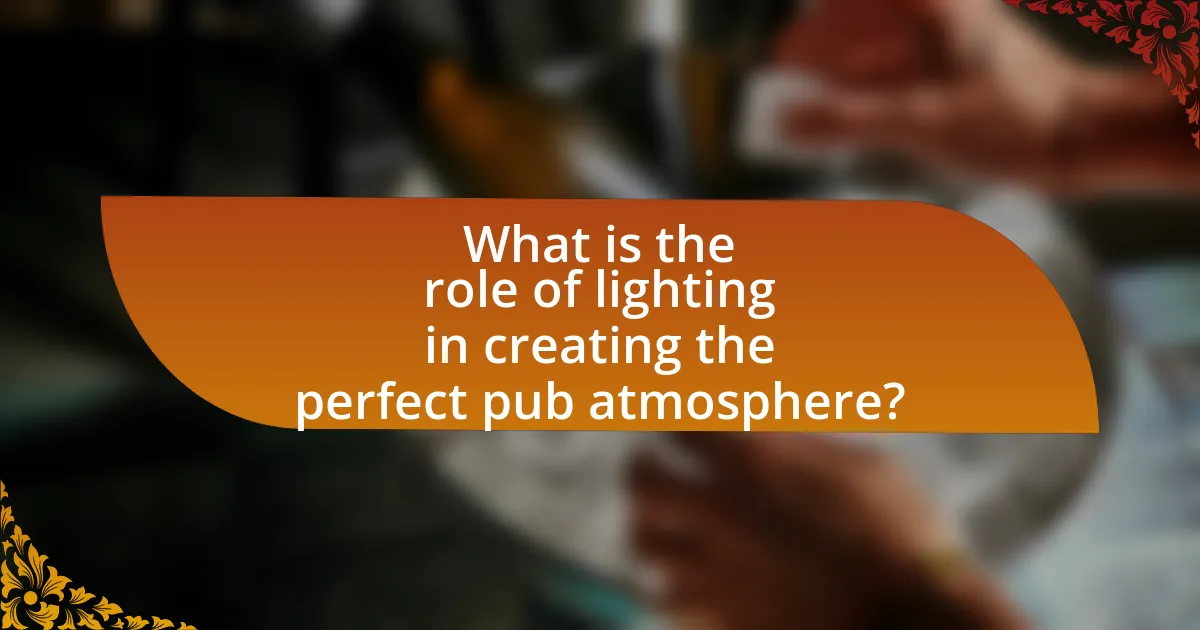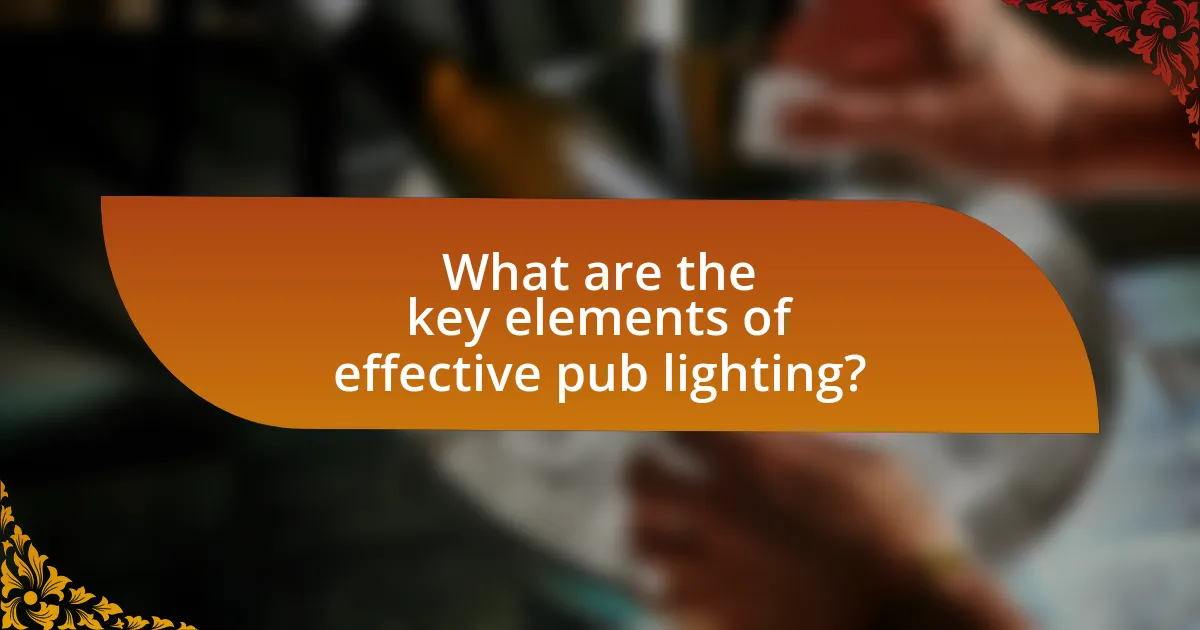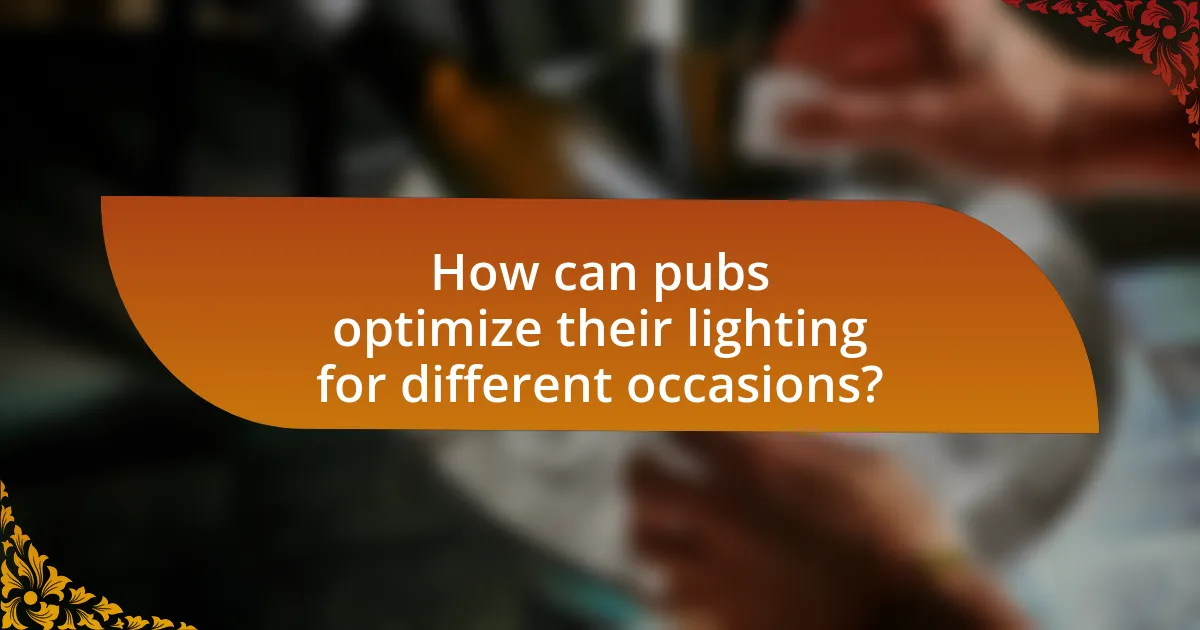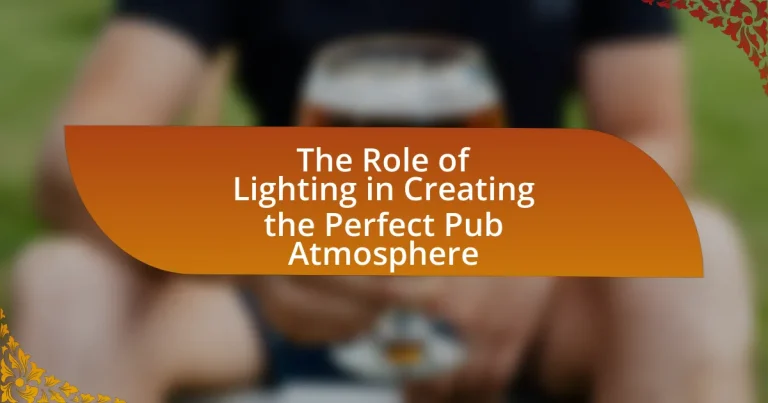The article focuses on the critical role of lighting in creating the ideal pub atmosphere. It explores how different lighting types—ambient, task, and accent—affect customer experience by influencing mood, comfort, and social interaction. Key elements such as brightness, color temperature, and strategic placement of lighting are discussed, highlighting their impact on ambiance and customer satisfaction. Additionally, the article addresses common mistakes in lighting design and offers practical tips for optimizing lighting for various occasions, ultimately emphasizing the importance of effective lighting in enhancing the overall pub experience.

What is the role of lighting in creating the perfect pub atmosphere?
Lighting plays a crucial role in creating the perfect pub atmosphere by influencing mood, comfort, and social interaction. The right lighting can enhance the overall experience, making patrons feel relaxed and inviting them to stay longer. Studies show that dim lighting encourages conversation and intimacy, while brighter lighting can energize the space and promote social engagement. For example, a study published in the Journal of Environmental Psychology indicates that warm, soft lighting can increase feelings of comfort and satisfaction in social settings. Thus, effective lighting design is essential for establishing the desired ambiance in a pub.
How does lighting influence customer experience in pubs?
Lighting significantly influences customer experience in pubs by affecting mood, comfort, and social interaction. Research indicates that warm lighting creates a welcoming atmosphere, encouraging patrons to stay longer and engage more with their surroundings. For instance, a study published in the Journal of Environmental Psychology found that dim lighting can enhance relaxation and promote socialization, leading to increased customer satisfaction. Conversely, overly bright lighting can create a sterile environment, detracting from the overall experience. Thus, the strategic use of lighting in pubs is essential for enhancing customer enjoyment and fostering a vibrant social atmosphere.
What types of lighting are commonly used in pubs?
Pubs commonly use ambient, task, and accent lighting to create a welcoming atmosphere. Ambient lighting provides overall illumination, often achieved through ceiling fixtures or wall sconces, ensuring patrons can navigate the space comfortably. Task lighting, such as pendant lights over tables or bar areas, focuses on specific activities like dining or drinking, enhancing functionality. Accent lighting, including spotlights or decorative fixtures, highlights architectural features or artwork, adding visual interest. These lighting types work together to establish a cozy and inviting environment, essential for a positive pub experience.
How does the intensity of lighting affect mood and ambiance?
The intensity of lighting significantly affects mood and ambiance by influencing emotional responses and perceptions of space. Bright lighting typically enhances alertness and energy, making environments feel more vibrant and stimulating, while dim lighting fosters relaxation and intimacy, creating a cozy atmosphere. Research indicates that different light levels can evoke specific feelings; for instance, a study published in the Journal of Environmental Psychology found that lower light levels can increase feelings of comfort and reduce stress, while brighter settings can enhance social interaction and engagement. Thus, the manipulation of lighting intensity is a crucial element in shaping the overall experience in spaces like pubs.
Why is lighting design important for pubs?
Lighting design is important for pubs because it directly influences the atmosphere, customer experience, and overall ambiance. Effective lighting can create a welcoming environment that encourages social interaction and enhances the enjoyment of food and drinks. Studies show that well-designed lighting can increase customer dwell time and spending; for instance, a report by the Lighting Research Center indicates that appropriate lighting can enhance mood and comfort, leading to a 20% increase in sales. Therefore, strategic lighting design is essential for maximizing both customer satisfaction and profitability in pubs.
What are the psychological effects of different lighting styles?
Different lighting styles significantly influence psychological states and behaviors. Warm lighting, often characterized by yellow or orange hues, tends to create a cozy and inviting atmosphere, promoting relaxation and social interaction, which is essential in a pub setting. In contrast, cool lighting, with blue or white tones, can enhance alertness and focus but may also induce feelings of coldness or sterility, potentially discouraging prolonged social engagement.
Research indicates that dim lighting can foster intimacy and encourage conversation, while bright lighting can stimulate activity and energy levels. A study published in the Journal of Environmental Psychology by Spence and Gallace (2011) highlights that lighting affects mood and social dynamics, suggesting that the right balance of lighting can enhance the overall experience in social environments like pubs.
How can lighting enhance the overall theme of a pub?
Lighting can enhance the overall theme of a pub by creating an inviting atmosphere that aligns with the pub’s concept and target audience. For instance, warm, dim lighting can evoke a cozy, intimate setting suitable for casual gatherings, while brighter, more vibrant lighting can energize a space for social events or sports viewing. Research indicates that lighting influences mood and behavior; a study published in the Journal of Environmental Psychology found that ambient lighting can significantly affect patrons’ perceptions of comfort and enjoyment in social settings. Thus, strategically designed lighting not only complements the pub’s theme but also enhances customer experience and satisfaction.

What are the key elements of effective pub lighting?
The key elements of effective pub lighting include brightness, color temperature, and flexibility in lighting design. Brightness should be adjustable to create a welcoming atmosphere, typically ranging from soft ambient lighting to brighter task lighting for specific areas like bars or dining tables. Color temperature plays a crucial role, with warmer tones (around 2700K to 3000K) fostering a cozy environment, while cooler tones can enhance focus and energy. Flexibility in lighting design allows for different moods throughout the day and for various events, utilizing dimmers, layered lighting, and accent lights to highlight features and create visual interest. These elements collectively contribute to an inviting and enjoyable pub experience.
How does color temperature impact the atmosphere in a pub?
Color temperature significantly impacts the atmosphere in a pub by influencing patrons’ mood and perception of the space. Warmer color temperatures, typically around 2700K to 3000K, create a cozy and inviting environment, encouraging relaxation and social interaction. In contrast, cooler color temperatures, ranging from 4000K to 5000K, can evoke a more energetic and alert atmosphere, which may be suitable for lively gatherings or events. Research indicates that lighting can affect emotional responses; for instance, a study published in the Journal of Environmental Psychology found that warm lighting enhances feelings of comfort and intimacy, while cooler lighting can increase alertness and focus. Thus, the choice of color temperature in a pub directly shapes the overall experience for customers.
What are the differences between warm and cool lighting?
Warm lighting typically has a color temperature ranging from 2700K to 3000K, creating a cozy and inviting atmosphere, while cool lighting has a color temperature of 4000K to 6500K, producing a brighter and more energizing environment. Warm lighting is often associated with relaxation and comfort, making it suitable for intimate settings like pubs, whereas cool lighting can enhance alertness and focus, which may be beneficial in more active or social environments. The distinction is based on the Kelvin scale, where lower values indicate warmer tones and higher values indicate cooler tones.
How can color schemes be used to create specific moods?
Color schemes can be used to create specific moods by influencing emotional responses through color psychology. For instance, warm colors like red and orange evoke feelings of warmth and excitement, making them suitable for lively environments such as pubs. In contrast, cool colors like blue and green promote calmness and relaxation, ideal for creating a more subdued atmosphere. Research indicates that color can affect mood and behavior; for example, a study published in the journal “Color Research and Application” found that colors significantly impact emotional perception and can enhance the overall experience in social settings. Thus, selecting appropriate color schemes is essential for establishing the desired ambiance in a pub.
What role does lighting placement play in pub design?
Lighting placement is crucial in pub design as it directly influences the ambiance and functionality of the space. Properly positioned lighting can enhance the aesthetic appeal, create a welcoming atmosphere, and guide customer movement within the pub. For instance, ambient lighting provides overall illumination, while task lighting focuses on specific areas like bars or tables, ensuring visibility for patrons. Studies show that well-placed lighting can increase customer satisfaction and dwell time, ultimately boosting sales. According to a report by the Lighting Research Center, effective lighting design can enhance the perceived quality of food and drink, making it a vital element in pub design.
How can strategic lighting placement improve visibility and comfort?
Strategic lighting placement enhances visibility and comfort by ensuring that areas are adequately illuminated while minimizing glare and harsh shadows. Properly positioned lights can highlight key features, such as seating areas and pathways, making it easier for patrons to navigate and enjoy their surroundings. Research indicates that well-designed lighting can increase perceived safety and comfort levels, as seen in a study by the Lighting Research Center, which found that appropriate lighting levels can reduce accidents and improve overall satisfaction in social environments.
What are the best practices for layering different types of lighting?
The best practices for layering different types of lighting include using ambient, task, and accent lighting to create a balanced and inviting atmosphere. Ambient lighting serves as the primary source of illumination, providing overall brightness; task lighting focuses on specific areas for activities like reading menus or playing games; and accent lighting highlights architectural features or artwork. This combination enhances the visual appeal and functionality of the space. Research indicates that effective lighting design can improve customer satisfaction and increase dwell time, which is crucial for pubs aiming to create a welcoming environment.

How can pubs optimize their lighting for different occasions?
Pubs can optimize their lighting for different occasions by adjusting brightness levels, color temperatures, and fixture types to match the desired atmosphere. For example, during lively events or sports broadcasts, brighter, cooler lighting can enhance energy and visibility, while softer, warmer lighting is ideal for intimate gatherings or romantic dinners, creating a cozy ambiance. Research indicates that lighting significantly influences mood and behavior; a study published in the Journal of Environmental Psychology found that warm lighting can increase feelings of comfort and relaxation, making it suitable for social interactions. By strategically using dimmers, colored LED lights, and task lighting, pubs can effectively tailor their lighting to enhance the overall experience for patrons based on the occasion.
What adjustments can be made for daytime versus nighttime lighting?
Daytime lighting adjustments typically involve maximizing natural light through large windows and using bright, warm artificial lights to create an inviting atmosphere. In contrast, nighttime lighting adjustments focus on creating a cozy ambiance by dimming lights, utilizing softer hues, and incorporating accent lighting to highlight specific areas or features within the pub. Research indicates that well-designed lighting can enhance customer experience and influence mood, with studies showing that brighter environments during the day can increase energy levels, while softer, warmer lighting at night promotes relaxation and social interaction.
How can lighting be adapted for special events or promotions?
Lighting can be adapted for special events or promotions by utilizing adjustable fixtures, color filters, and programmable lighting systems. Adjustable fixtures allow for varying intensities and angles, creating different moods suitable for events like live music or themed parties. Color filters can change the ambiance to match specific themes or branding, enhancing the visual appeal and engagement of the event. Programmable lighting systems enable dynamic changes throughout the event, such as transitioning from bright, energetic lighting during a promotional announcement to softer, ambient lighting for socializing. These adaptations are supported by studies showing that appropriate lighting significantly influences customer mood and behavior, ultimately enhancing the overall experience in a pub setting.
What are the considerations for seasonal lighting changes?
Seasonal lighting changes in pubs require careful consideration of ambiance, energy efficiency, and customer comfort. Adjusting lighting to reflect seasonal themes enhances the overall atmosphere; for example, warmer tones in winter create a cozy environment, while brighter, cooler tones in summer promote a lively feel. Energy efficiency is crucial, as seasonal changes can impact electricity costs; utilizing LED lighting can reduce energy consumption significantly, with LEDs using up to 75% less energy than traditional bulbs. Additionally, customer comfort should be prioritized; studies show that appropriate lighting levels can influence mood and social interaction, making it essential to adapt lighting to seasonal variations in natural light.
What are some common mistakes to avoid in pub lighting design?
Common mistakes to avoid in pub lighting design include inadequate lighting levels, poor fixture placement, and neglecting the ambiance. Inadequate lighting can lead to a dim atmosphere that discourages patrons, while overly bright lighting can create discomfort. Poor fixture placement may result in uneven lighting, casting shadows that detract from the overall experience. Additionally, neglecting the desired ambiance can lead to a mismatch between lighting and the pub’s theme, which can confuse or alienate customers. Research indicates that well-designed lighting significantly enhances customer satisfaction and dwell time, making these mistakes critical to avoid for a successful pub environment.
How can poor lighting choices negatively impact customer experience?
Poor lighting choices can significantly diminish customer experience by creating an uncomfortable or uninviting atmosphere. For instance, overly bright lighting can lead to glare, making it difficult for customers to relax and enjoy their time, while insufficient lighting can cause strain on the eyes and hinder visibility, leading to frustration. Research indicates that 70% of customers prefer a well-lit environment that enhances their mood and encourages longer stays, which directly correlates with increased spending. Therefore, inadequate lighting not only affects comfort but also impacts customer retention and overall satisfaction.
What are the signs of ineffective lighting in a pub setting?
Ineffective lighting in a pub setting is indicated by dimly lit areas that hinder visibility, creating a gloomy atmosphere. This can lead to patrons feeling uncomfortable or unsafe, as they struggle to see their surroundings or read menus. Additionally, harsh or overly bright lighting can cause glare, making it difficult for customers to relax and enjoy their experience. Inconsistent lighting levels throughout the space can also disrupt the ambiance, leading to a disjointed feel. According to a study by the Lighting Research Center, proper lighting significantly impacts customer satisfaction and can influence the duration of their stay, highlighting the importance of effective lighting in enhancing the overall pub experience.
What practical tips can pubs implement for effective lighting?
Pubs can implement effective lighting by using a combination of ambient, task, and accent lighting to create a welcoming atmosphere. Ambient lighting provides overall illumination, which can be achieved through ceiling fixtures or wall sconces, ensuring the space is well-lit without being harsh. Task lighting, such as pendant lights over tables or bar areas, enhances functionality for activities like dining or socializing. Accent lighting, like LED strips or spotlights on artwork, adds visual interest and highlights specific areas, contributing to the pub’s character. Research indicates that well-designed lighting can increase customer satisfaction and dwell time, ultimately boosting sales.


